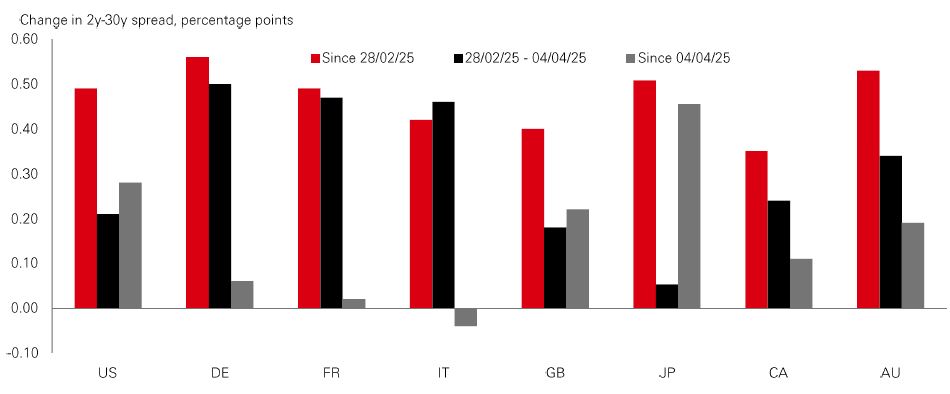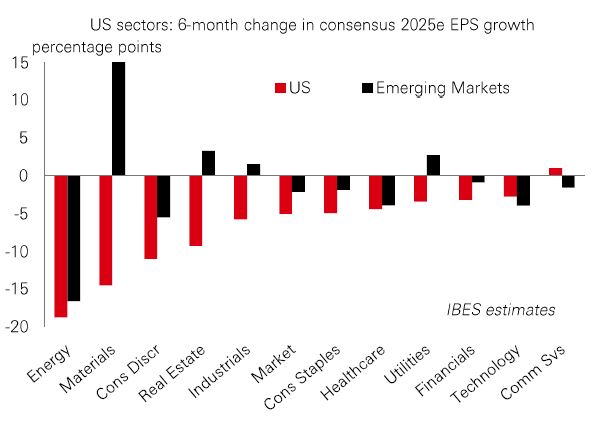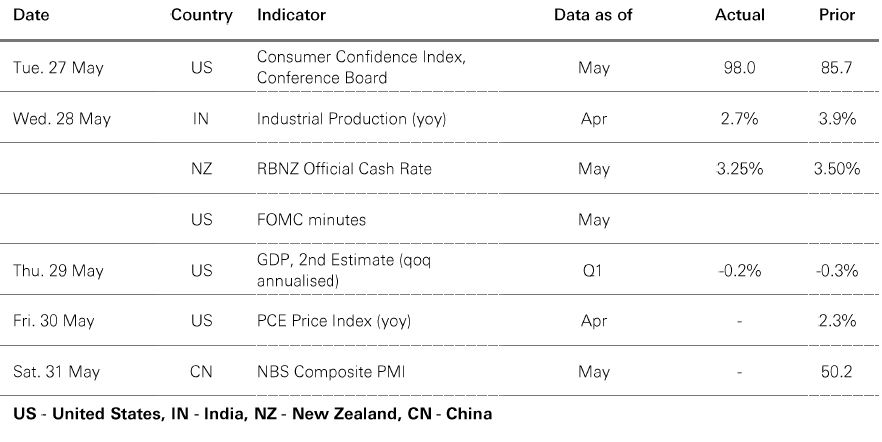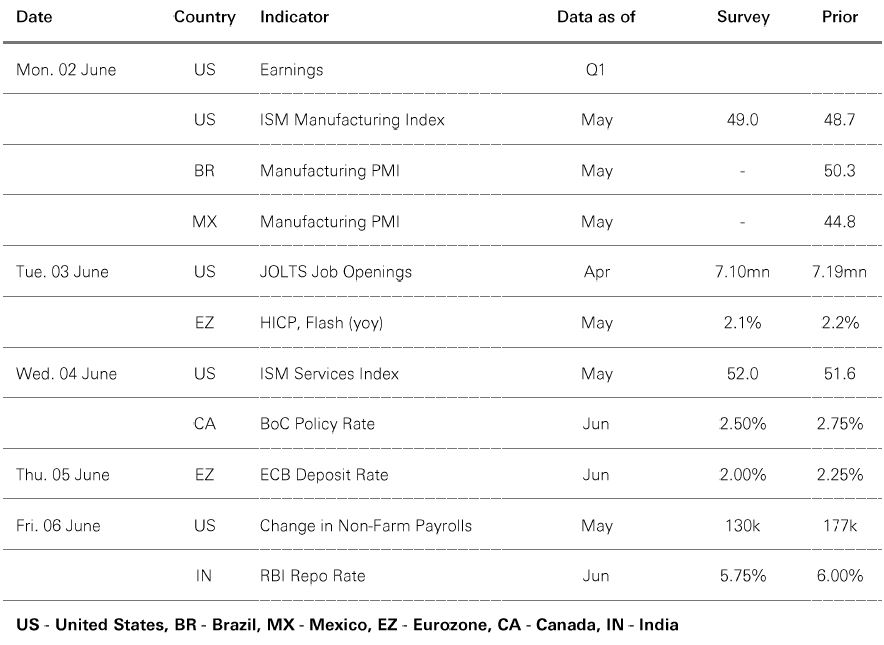
2 June 2025

The “bond market vigilantes” have been spotted riding back into town. Yields on long-dated bonds across the G7 have been rising recently, with a marked steepening in 2y-30y spreads since the end of February.
The initial pick-up in yields during March coincided with the news of a major fiscal support package in Germany, which boosted Bund yields along with their French and Italian equivalents and likely pushed up yields globally. This element of the move in long-dated rates can be seen as positive – reflecting a reflation of the eurozone economy driven by the country with ample fiscal space to do it.
Since early April, the 2y-30y spreads for Germany, France and Italy have moved very little, but those for the US, Japan and the UK have moved higher. This is potentially more worrying. It coincides with a spike in US policy uncertainty, forcing higher bond risk premiums, together with growing concerns about the fiscal position of the US, Japan, and the UK.
The US administration’s fiscal plans imply a further widening of the deficit from an already-unsustainable level. Japan’s gross government debt of well over 200% of GDP is sustainable in a low global rate environment, but not when global yields move to pre-GFC levels. As Japanese yields rise, self-reinforcing dynamics can take over – with higher yields raising questions over sustainability, driving risk premiums higher, in turn putting more pressure on sustainability.
For investors, developments in the bond market – and the impact on asset prices – is a key focus. With US Treasuries in turmoil, traditional safe assets are less reliable (see page 2), while higher rates could eventually weigh on stocks. With the risk of “deficits forever”, the bond vigilantes won’t be leaving any time soon.
Over the next 25 years, investments totalling an estimated USD150 trillion are going to be needed to achieve global energy transition targets. Key to that will be the development of infrastructure projects in areas like clean energy, transport, and digital. It comes at a time when traditional lending is scaling back in this space – and according to some Infrastructure Debt specialists, it’s leaving a financing gap that is driving strong demand from both companies and investors for private credit in infrastructure funding.
Large-scale infrastructure projects often attract financing from major institutions, which is why infrastructure debt has historically been dominated by insurance companies seeking long-term, investment-grade assets. Yet, specialists see mid-market deals (of USD50-250 million) remaining largely underserved. It is an area now attracting pension funds, family offices, and investors seeking higher-yield, shorter-duration opportunities. For investors that allocated heavily to direct lending in recent years, it also offers a potentially lower-risk alternative while still offering attractive returns versus public markets. Overall, the synergy between private credit and infrastructure financing is reshaping how institutional investors approach alternative assets.
The value of investments and any income from them can go down as well as up and investors may not get back the amount originally invested. Past performance does not predict future returns. The level of yield is not guaranteed and may rise or fall in the future. For informational purposes only and should not be construed as a recommendation to invest in the specific country, product, strategy, sector, or security. Diversification does not ensure a profit or protect against loss. Any views expressed were held at the time of preparation and are subject to change without notice. Any forecast, projection or target where provided is indicative only and is not guaranteed in any way. Source: HSBC Asset Management, Bloomberg. Data as at 7.30am UK time 30 May 2025.
Emerging market local currency debt looks positioned to do well in a backdrop of high real yields, strong fundamentals, and a weakening US dollar. Indeed, strengthening EM currencies, combined with falling inflation, are allowing EM central banks to ease policy, further boosting the appeal of EM local bond markets to global investors. And while US tariffs could drag on growth, the demand shock could be disinflationary for EMs, potentially speeding up their policy easing cycles. |
Despite broad tailwinds, it makes sense to take a differentiated view of the EM bond universe. EM currencies – especially those backed by large external surpluses, some of them in Asia – are likely to outperform. EMs have built up buffers against external risks at differing speeds, and they have varying exposure to global trade. For Indonesian bonds, historically high real yields, low inflation, manageable external balances, moderate debt levels, and reassurance from the finance minister have alleviated market concerns over fiscal risks.

Last week saw the last of the Magnificent Seven mega-caps deliver Q1 profits numbers – which once again beat analyst expectations. Overall, US Q1 profits have delivered a bang, growing 13% year-on-year versus an expected 7% at the start of the quarter. But while sectors like healthcare and technology have raised guidance for the full year, most sectors are pencilling-in flat to falling growth in 2025. In fact, consensus y-o-y profits growth for 2025 has fallen from 14% in January to just over 9% today. Energy, materials and consumer discretionary have seen the deepest downgrades. Revisions in consumer discretionary follow a stellar run for the sector, which is up by 218% over 10 years. But with a 12-month forward price/earnings valuation of 29x (higher than US Tech on 27x). Industrials, which is not cheap on 23x, has exposure to the US government's focus on infrastructure and re-shoring. |
Beyond the US, full year consensus for Emerging Markets are better in most sectors. And with EM on a PE of 12.3x versus the US on 21.5x, EM stocks could offer more of a valuation buffer against setbacks.

Research by some ETF and Indexing teams shows the current correlation landscape resembles patterns seen in the 1970s, 80s, and early 90s – a time when inflationary pressures drove positive correlations between stocks and bonds. The relationship between inflation and economic growth influences how asset classes behave relative to each other. When inflation dominates, as it has post-pandemic, bonds are a less reliable hedge. That’s compounded by concerns over high deficits keeping bond yields sticky. In sum, it poses a challenge to the 60/40 model and may require a change in how investors think about risk and diversification.

Past performance does not predict future returns. The level of yield is not guaranteed and may rise or fall in the future. For informational purposes only and should not be construed as a recommendation to invest in the specific country, product, strategy, sector, or security. Diversification does not ensure a profit or protect against loss. Any views expressed were held at the time of preparation and are subject to change without notice. Index returns assume reinvestment of all distributions and do not reflect fees or expenses. You cannot invest directly in an index. Any forecast, projection or target where provided is indicative only and is not guaranteed in any way. Source: HSBC Asset Management. Macrobond, Bloomberg. Data as at 7.30am UK time 30 May 2025.


Source: HSBC Asset Management. Data as at 7.30am UK time 30 May 2025. For informational purposes only and should not be construed as a recommendation to invest in the specific country, product, strategy, sector or security. Any views expressed were held at the time of preparation and are subject to change without notice. Any forecast, projection or target where provided is indicative only and is not guaranteed in any way.
Risk sentiment strengthened last week as the Q1 earnings season neared its end, and investors continued to monitor the trade negotiations and tariff developments. The dollar index rebounded modestly, and Treasury yields pulled back following solid auction results. European yields also declined. US and Euro credit spreads narrowed, with HY outperforming IG. US equities saw broad-based gains, recovering some of the prior week's losses. European markets broadly advanced, as Japan's Nikkei 225 rose amid a weaker yen and a retreat in JGB yields. Other Asian equities lacked clear direction, with South Korea's Kospi leading gains. India's Sensex and China’s Shanghai Composite traded sideways, while Hang Seng fell. In commodities, oil prices declined before an OPEC+ meeting to discuss July output, accompanied by softer gold and copper prices.




This document or video is prepared by The Hongkong and Shanghai Banking Corporation Limited (‘HBAP’), 1 Queen’s Road Central, Hong Kong. HBAP is incorporated in Hong Kong and is part of the HSBC Group. This document or video is distributed and/or made available, HSBC Bank (China) Company Limited, HSBC Bank (Singapore) Limited, HSBC Bank Middle East Limited (UAE), HSBC UK Bank Plc, HSBC Bank Malaysia Berhad (198401015221 (127776-V))/HSBC Amanah Malaysia Berhad (20080100642 1 (807705-X)), HSBC Bank (Taiwan) Limited, HSBC Bank plc, Jersey Branch, HSBC Bank plc, Guernsey Branch, HSBC Bank plc in the Isle of Man, HSBC Continental Europe, Greece, The Hongkong and Shanghai Banking Corporation Limited, India (HSBC India), HSBC Bank (Vietnam) Limited, PT Bank HSBC Indonesia (HBID), HSBC Bank (Uruguay) S.A. (HSBC Uruguay is authorised and oversought by Banco Central del Uruguay), HBAP Sri Lanka Branch, The Hongkong and Shanghai Banking Corporation Limited – Philippine Branch, HSBC Investment and Insurance Brokerage, Philippines Inc, and HSBC FinTech Services (Shanghai) Company Limited and HSBC Mexico, S.A. Multiple Banking Institution HSBC Financial Group (collectively, the “Distributors”) to their respective clients. This document or video is for general circulation and information purposes only.
The contents of this document or video may not be reproduced or further distributed to any person or entity, whether in whole or in part, for any purpose. This document or video must not be distributed in any jurisdiction where its distribution is unlawful. All non-authorised reproduction or use of this document or video will be the responsibility of the user and may lead to legal proceedings. The material contained in this document or video is for general information purposes only and does not constitute investment research or advice or a recommendation to buy or sell investments. Some of the statements contained in this document or video may be considered forward looking statements which provide current expectations or forecasts of future events. Such forward looking statements are not guarantees of future performance or events and involve risks and uncertainties. Actual results may differ materially from those described in such forward-looking statements as a result of various factors. HBAP and the Distributors do not undertake any obligation to update the forward-looking statements contained herein, or to update the reasons why actual results could differ from those projected in the forward-looking statements. This document or video has no contractual value and is not by any means intended as a solicitation, nor a recommendation for the purchase or sale of any financial instrument in any jurisdiction in which such an offer is not lawful. The views and opinions expressed are based on the HSBC Global Investment Committee at the time of preparation and are subject to change at any time. These views may not necessarily indicate HSBC Asset Management‘s current portfolios’ composition. Individual portfolios managed by HSBC Asset Management primarily reflect individual clients’ objectives, risk preferences, time horizon, and market liquidity.
The value of investments and the income from them can go down as well as up and investors may not get back the amount originally invested. Past performance contained in this document or video is not a reliable indicator of future performance whilst any forecasts, projections and simulations contained herein should not be relied upon as an indication of future results. Where overseas investments are held the rate of currency exchange may cause the value of such investments to go down as well as up. Investments in emerging markets are by their nature higher risk and potentially more volatile than those inherent in some established markets. Economies in emerging markets generally are heavily dependent upon international trade and, accordingly, have been and may continue to be affected adversely by trade barriers, exchange controls, managed adjustments in relative currency values and other protectionist measures imposed or negotiated by the countries with which they trade. These economies also have been and may continue to be affected adversely by economic conditions in the countries in which they trade. Investments are subject to market risks, read all investment related documents carefully.
This document or video provides a high-level overview of the recent economic environment and has been prepared for information purposes only. The views presented are those of HBAP and are based on HBAP’s global views and may not necessarily align with the Distributors’ local views. It has not been prepared in accordance with legal requirements designed to promote the independence of investment research and is not subject to any prohibition on dealing ahead of its dissemination. It is not intended to provide and should not be relied on for accounting, legal or tax advice. Before you make any investment decision, you may wish to consult an independent financial adviser. In the event that you choose not to seek advice from a financial adviser, you should carefully consider whether the investment product is suitable for you. You are advised to obtain appropriate professional advice where necessary.
The accuracy and/or completeness of any third-party information obtained from sources which we believe to be reliable might have not been independently verified, hence Customer must seek from several sources prior to making investment decision.
The following statement is only applicable to HSBC Mexico, S.A. Multiple Banking Institution HSBC Financial Group with regard to how the publication is distributed to its customers: This publication is distributed by Wealth Insights of HSBC México, and its objective is for informational purposes only and should not be interpreted as an offer or invitation to buy or sell any security related to financial instruments, investments or other financial product. This communication is not intended to contain an exhaustive description of the considerations that may be important in making a decision to make any change and/or modification to any product, and what is contained or reflected in this report does not constitute, and is not intended to constitute, nor should it be construed as advice, investment advice or a recommendation, offer or solicitation to buy or sell any service, product, security, merchandise, currency or any other asset.
Receiving parties should not consider this document as a substitute for their own judgment. The past performance of the securities or financial instruments mentioned herein is not necessarily indicative of future results. All information, as well as prices indicated, are subject to change without prior notice; Wealth Insights of HSBC Mexico is not obliged to update or keep it current or to give any notification in the event that the information presented here undergoes any update or change. The securities and investment products described herein may not be suitable for sale in all jurisdictions or may not be suitable for some categories of investors.
The information contained in this communication is derived from a variety of sources deemed reliable; however, its accuracy or completeness cannot be guaranteed. HSBC México will not be responsible for any loss or damage of any kind that may arise from transmission errors, inaccuracies, omissions, changes in market factors or conditions, or any other circumstance beyond the control of HSBC. Different HSBC legal entities may carry out distribution of Wealth Insights internationally in accordance with local regulatory requirements.
Important Information about the Hongkong and Shanghai Banking Corporation Limited, India (“HSBC India”)
HSBC India is a branch of The Hongkong and Shanghai Banking Corporation Limited. HSBC India is a distributor of mutual funds and referrer of investment products from third party entities registered and regulated in India. HSBC India does not distribute investment products to those persons who are either the citizens or residents of United States of America (USA), Canada or New Zealand or any other jurisdiction where such distribution would be contrary to law or regulation.
The following statement is only applicable to HSBC Bank (Taiwan) Limited with regard to how the publication is distributed to its customers: HSBC Bank (Taiwan) Limited (“the Bank”) shall fulfill the fiduciary duty act as a reasonable person once in exercising offering/conducting ordinary care in offering trust services/ business. However, the Bank disclaims any guarantee on the management or operation performance of the trust business.
The following statement is only applicable to PT Bank HSBC Indonesia (“HBID”): PT Bank HSBC Indonesia (“HBID”) is licensed and supervised by Indonesia Financial Services Authority (“OJK”). Customer must understand that historical performance does not guarantee future performance. Investment product that are offered in HBID is third party products, HBID is a selling agent for third party product such as Mutual Fund and Bonds. HBID and HSBC Group (HSBC Holdings Plc and its subsidiaries and associates company or any of its branches) does not guarantee the underlying investment, principal or return on customer investment. Investment in Mutual Funds and Bonds is not covered by the deposit insurance program of the Indonesian Deposit Insurance Corporation (LPS).
Important information on ESG and sustainable investing
Today we finance a number of industries that significantly contribute to greenhouse gas emissions. We have a strategy to help our customers to reduce their emissions and to reduce our own. For more information visit www.hsbc.com/sustainability.
In broad terms “ESG and sustainable investing” products include investment approaches or instruments which consider environmental, social, governance and/or other sustainability factors to varying degrees. Certain instruments we classify as sustainable may be in the process of changing to deliver sustainability outcomes. There is no guarantee that ESG and Sustainable investing products will produce returns similar to those which don’t consider these factors. ESG and Sustainable investing products may diverge from traditional market benchmarks. In addition, there is no standard definition of, or measurement criteria for, ESG and Sustainable investing or the impact of ESG and Sustainable investing products. ESG and Sustainable investing and related impact measurement criteria are (a) highly subjective and (b) may vary significantly across and within sectors.
HSBC may rely on measurement criteria devised and reported by third party providers or issuers. HSBC does not always conduct its own specific due diligence in relation to measurement criteria. There is no guarantee: (a) that the nature of the ESG / sustainability impact or measurement criteria of an investment will be aligned with any particular investor’s sustainability goals; or (b) that the stated level or target level of ESG / sustainability impact will be achieved. ESG and Sustainable investing is an evolving area and new regulations are being developed which will affect how investments can be categorised or labelled. An investment which is considered to fulfil sustainable criteria today may not meet those criteria at some point in the future.
THE CONTENTS OF THIS DOCUMENT OR VIDEO HAVE NOT BEEN REVIEWED BY ANY REGULATORY AUTHORITY IN HONG KONG OR ANY OTHER JURISDICTION. YOU ARE ADVISED TO EXERCISE CAUTION IN RELATION TO THE INVESTMENT AND THIS DOCUMENT OR VIDEO. IF YOU ARE IN DOUBT ABOUT ANY OF THE CONTENTS OF THIS DOCUMENT OR VIDEO, YOU SHOULD OBTAIN INDEPENDENT PROFESSIONAL ADVICE.
© Copyright 2025. The Hongkong and Shanghai Banking Corporation Limited, ALL RIGHTS RESERVED.
No part of this document or video may be reproduced, stored in a retrieval system, or transmitted, on any form or by any means, electronic, mechanical, photocopying, recording or otherwise, without the prior written permission of The Hongkong and Shanghai Banking Corporation Limited.